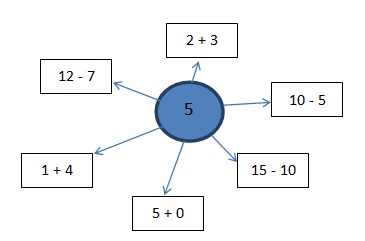“Teachers should use every relevant subject to develop pupils’ mathematical fluency. Confidence in numeracy and other mathematical skills is a precondition of success across the national curriculum.”
– The National Curriculum in England Framework document, September 2013, page 10
Making connections to other topics within this year group
Multiplication and division
When working on addition and subtraction and/or multiplication and division, there are opportunities to make connections between them, for example:
Multiplication must be understood both as ‘repeated addition’ and as ‘scaling’. Likewise, division is both ‘repeated subtraction’ and reduction (multiply by a scale factor of less than 1). You should model these concepts using manipulatives including bead strings and arrays. For example:
Give each child a bead string with 20 beads on it. Ask them to find 3 multiplied by 4 by moving 3 beads at a time four times giving 12. Next, ask them to divide 12 by 3 by taking away groups of 3. As they do this you could demonstrate what they are doing on a number line. It is important that the children use practical apparatus before using a number line because a number line alone is too abstract for some children.
Give the children 12 counters and ask them to set these out in three rows of four on a piece of paper or a whiteboard:

Discuss how they can make 12 by adding four three times, and, if they turn their array around they can add three four times. They could record these as addition and multiplication number sentences.
Fractions
When working on addition and subtraction and/or fractions there are opportunities to make connections between them, for example:
You could give the children opportunities to find halves and quarters of different quantities, for example 20. They could find half by dividing by two or sharing single a set of 20 objects into two piles. They could then count how many are in each half and then add them together to check that when they do they get the whole amount. They could do the same for quarters, adding two groups to find two quarters or ½ and three for ¾.
Measurement
When working on addition and subtraction and/or measurement there are opportunities to make connections between them, for example:
You could ask the children to measure different lengths in metres using metre sticks or centimetres using rulers. They could then find totals or differences of pairs of lengths. They could repeat this for measuring masses in kilograms and capacities or volumes in litres.
Making connections to this topic in adjacent year groups
Early Years Foundation Stage
- Children count reliably with numbers from one to 20, place them in order and say which number is one more or one less than a given number.
- Using quantities and objects, they add and subtract two single-digit numbers and count on or back to find the answer.
Year 2
- solve problems with addition and subtraction:
- using concrete objects and pictorial representations, including those involving numbers, quantities and measures
- applying their increasing knowledge of mental and written methods
- recall and use addition and subtraction facts to 20 fluently, and derive and use related facts up to 100
- add and subtract numbers using concrete objects, pictorial representations, and mentally, including:
- a two-digit number and ones
- a two-digit number and tens
- two two-digit numbers
- adding three one-digit numbers
- show that addition of two numbers can be done in any order (commutative) and subtraction of one number from another cannot
- recognise and use the inverse relationship between addition and subtraction and use this to check calculations and solve missing number problems
Non statutory guidance
Pupils extend their understanding of the language of addition and subtraction to include sum and difference.
Pupils practise addition and subtraction to 20 to become increasingly fluent in deriving facts such as using 3 + 7 = 10; 10 – 7 = 3 and 7 = 10 – 3 to calculate 30 + 70 = 100; 100 – 70 = 30 and 70 = 100 – 30. They check their calculations, including by adding to check subtraction and adding numbers in a different order to check addition (for example, 5 + 2 + 1 = 1 + 5 + 2 = 1 + 2 + 5). This establishes commutativity and associativity of addition.
Recording addition and subtraction in columns supports place value and prepares for formal written methods with larger numbers.
Cross-curricular and real life connections
Learners will encounter addition and subtraction:
Within the science curriculum there are opportunities to connect with addition and subtraction, for example, in the programmes of study the children are expected to use their local environment throughout the year to explore and answer questions about animals in their habitat. They need to be able to sort and group them. This would give opportunities for children add and subtract to find totals and differences.
Within the geography curriculum, the children are expected to identify seasonal and daily weather patterns in the United Kingdom and the location of hot and cold areas of the world in relation to the Equator and the North and South Poles. When they do this they could use subtraction to find differences in the temperatures of the different areas.
Within the history curriculum, the children are expected to explore where the people and events they study fit within a chronological framework. This could involve using subtraction or counting on to find time differences between these events. They could use addition to find, for example the number of years the people they studied lived or the lengths of reign of different Kings and Queens.


